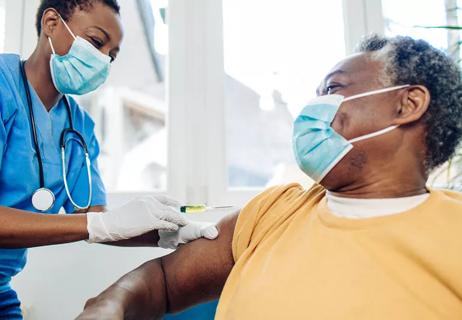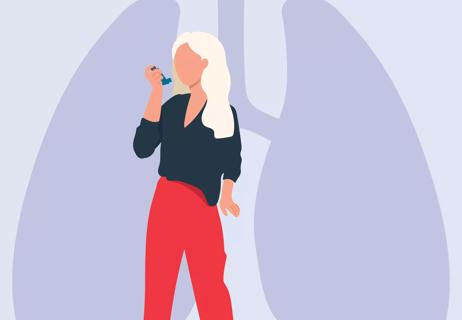It comes down to a wheeze, a fever and long-term effects

As if parenting wasn’t hard enough, COVID-19 has made the “sick kid questions” even more confusing: Is it just a cold or something else? Can I send my child to school? When should I call their healthcare provider?
Advertisement
Cleveland Clinic is a non-profit academic medical center. Advertising on our site helps support our mission. We do not endorse non-Cleveland Clinic products or services. Policy
“Every child runs a gauntlet of infections during the first five years of their life,” says pediatric infectious disease specialist Frank Esper, MD. “Navigating childhood illnesses can be challenging for parents.”
Dr. Esper explains how RSV, the flu and COVID-19 symptoms are similar and how they differ.
RSV, flu and COVID-19 are respiratory viruses. These viruses affect your respiratory system — the network of tissues and organs that help you breathe.
“Cough, runny nose and fever are common to all respiratory viruses,” says Dr. Esper. “When I see a child with these symptoms, I usually rely on a laboratory test to make an accurate diagnosis.”
When it comes to RSV vs. the flu vs. COVID-19, what should you look for? Dr. Esper says there are some subtle differences between RSV, the flu and COVID-19.
| Symptoms | RSV | Flu | COVID-19 |
|---|---|---|---|
| Sore throat | — | Common | Common |
| Cough | Common | Common | Common |
| Sneezing | Common | Sometimes | — |
| Fever | Sometimes | Common | Common |
| Body aches | Sometimes | Common | Sometimes |
| Tiredness | Sometimes | Common | Sometimes |
| Headache | Sometimes | Common | Sometimes |
| Runny/stuffy nose | Common | Sometimes | Sometimes |
| Shortness of breath | Sometimes | Sometimes | Sometimes |
| Loss of taste and/smell | — | — | Sometimes |
| Symptoms | |||
| Sore throat | |||
| RSV | |||
| — | |||
| Flu | |||
| Common | |||
| COVID-19 | |||
| Common | |||
| Cough | |||
| RSV | |||
| Common | |||
| Flu | |||
| Common | |||
| COVID-19 | |||
| Common | |||
| Sneezing | |||
| RSV | |||
| Common | |||
| Flu | |||
| Sometimes | |||
| COVID-19 | |||
| — | |||
| Fever | |||
| RSV | |||
| Sometimes | |||
| Flu | |||
| Common | |||
| COVID-19 | |||
| Common | |||
| Body aches | |||
| RSV | |||
| Sometimes | |||
| Flu | |||
| Common | |||
| COVID-19 | |||
| Sometimes | |||
| Tiredness | |||
| RSV | |||
| Sometimes | |||
| Flu | |||
| Common | |||
| COVID-19 | |||
| Sometimes | |||
| Headache | |||
| RSV | |||
| Sometimes | |||
| Flu | |||
| Common | |||
| COVID-19 | |||
| Sometimes | |||
| Runny/stuffy nose | |||
| RSV | |||
| Common | |||
| Flu | |||
| Sometimes | |||
| COVID-19 | |||
| Sometimes | |||
| Shortness of breath | |||
| RSV | |||
| Sometimes | |||
| Flu | |||
| Sometimes | |||
| COVID-19 | |||
| Sometimes | |||
| Loss of taste and/smell | |||
| RSV | |||
| — | |||
| Flu | |||
| — | |||
| COVID-19 | |||
| Sometimes |
RSV, or respiratory syncytial virus, is a virus nearly all children get by age 2. In addition to a cough, runny nose and fever, a unique symptom of RSV is wheezing. A wheeze sounds like a whistle or rattle when your child breathes.
Most children recover from RSV on their own, but sometimes, it can lead to severe illnesses such as:
Advertisement
RSV can infect people of any age, but is most serious for young children and older adults. According to the Centers for Disease Control and Prevention (CDC), U.S. hospitals admits an estimated 58,000-80,000 children under age 5 for RSV every year.
A distinctive sign of the flu is a very high fever. Along with other respiratory symptoms, the flu causes high fevers of 103 or 104 degrees Fahrenheit (39.44 or 40 degrees Celsius). People usually feel miserable, more so than with other viruses, says Dr. Esper. This can include nausea and vomiting as well, which, though not unique to the flu, is also often worse than with other viruses.
Children under age 5, and especially under age 2, are at higher risk of complications from the flu. These include:
Each year, between 6,000 and 27,000 children younger than 5 years old develop symptoms serious enough to require hospitalization.
The signs of COVID-19 are similar to flu and RSV. But unlike the other viruses, COVID-19 can have a serious effect on body systems outside the lungs.
“Flu can do this, too, but the symptoms usually go away once the virus leaves your lungs,” states Dr. Esper. “COVID can cause long-term effects, such as brain fog.”
Several symptoms you may think are unique to COVID-19 are actually common among respiratory viruses. For example:
If your child has a runny nose, cough and fever — the telltale signs of a respiratory virus — a COVID-19 test is a good first step. Knowing if your kid has COVID-19 can help you protect other family members and prevent the spread outside of your household.
Many clinics use a triple test that can detect RSV, the flu and COVID-19. And you can also buy an at-home PCR test that includes testing for RSV, flu and COVID-19. But Dr. Esper notes you won’t get immediate results because you have to send the sample to a lab for processing.
“The processing time is 24 to 48 hours after they receive the test,” he explains. “Therefore, it can be several days before you find the results.”
Home testing for RSV and flu has many benefits:
Advertisement
Co-infection — when you have multiple viruses at once — is common in children. In any childcare or preschool room, you’ll find children sick with a range of viruses.
“When they’re all coughing, it’s not surprising that a child can catch two or even three viruses at the same time,” notes Dr. Esper. “We saw co-infections before the pandemic, and we’re seeing them now with RSV, flu and COVID-19.”
But he hasn’t seen any evidence that having more than one virus leads to worse symptoms or outcomes. Providers treat infections the same way, whether there are one or three.
In addition to wearing a mask and physical distancing, these steps can reduce your risk of respiratory infections:
Additionally, it’s helpful to keep your child home if they’re sick. This minimizes the risk of spreading illness to other children at school.
Children usually recover from respiratory viruses on their own with rest and fluids. Dr. Esper recommends reaching out to your child’s healthcare provider if they have:
Advertisement
If your child has a high fever and you suspect it’s the flu, get in touch with their provider right away. Early treatment with Tamiflu within the first two days of symptoms can help your child get better faster.
Also check with your provider sooner if your child has any underlying health conditions, such as:
Respiratory infections are common in childhood. While you can take steps to reduce your child’s risk, you can’t avoid them entirely. If your child is sick, keep them home to reduce the spread of infection to others in your community. As they recover, your child will develop immunity that will help protect them from future infections.
Advertisement
Learn more about our editorial process.
Advertisement

Adults 60 or older, pregnant people and babies can get protected against the respiratory virus

Babies should get the RSV immunization before their first cold and flu season

Taking extra precaution during RSV season can be lifesaving

Our most at-risk populations are still highly affected by RSV

RSV spreads easily and can infect anybody — not just children

People with certain pre-existing medical conditions have increased risk factors

TLC = keeping them home, letting them rest, managing their fever and maintaining their hydration

Changes to the virus cycle put more importance on taking proper precautions

Type 2 diabetes isn’t inevitable with these dietary changes

Applying a hot or cold compress can help with pain